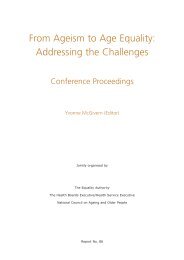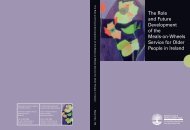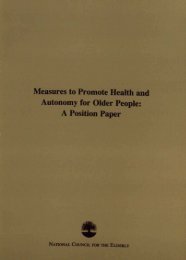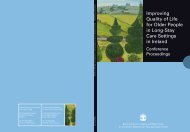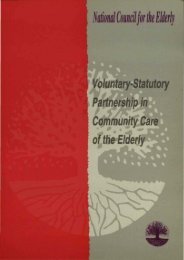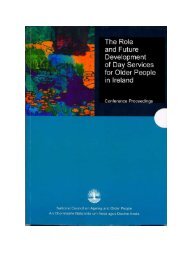Improving Quality of Life for Older People in Long-Stay Care ...
Improving Quality of Life for Older People in Long-Stay Care ...
Improving Quality of Life for Older People in Long-Stay Care ...
- No tags were found...
You also want an ePaper? Increase the reach of your titles
YUMPU automatically turns print PDFs into web optimized ePapers that Google loves.
The results <strong>of</strong> this particular study place a lot <strong>of</strong> weight on more objective quality<strong>of</strong> life measures such as physical health, liv<strong>in</strong>g environment and economic status.However, psychological health also emerged as be<strong>in</strong>g important, as did social function.The presence <strong>of</strong> religion and death reflects the importance <strong>of</strong> the metaphysical <strong>in</strong><strong>in</strong>fluenc<strong>in</strong>g the quality <strong>of</strong> life <strong>of</strong> older people.<strong>Quality</strong> <strong>of</strong> life doma<strong>in</strong>s <strong>for</strong> residents <strong>in</strong> long-stay care have also been <strong>in</strong>vestigated.Kane (2003a; 2003b; 2003c) carried out a study to identify factors <strong>in</strong>fluenc<strong>in</strong>g nurs<strong>in</strong>ghome residents’ quality <strong>of</strong> life that were not considered <strong>in</strong> exist<strong>in</strong>g quality <strong>of</strong> caremeasures. The study focused primarily on the psychological and social aspects <strong>of</strong>quality <strong>of</strong> life. In order to identify relevant quality <strong>of</strong> life doma<strong>in</strong>s, a literature reviewwas carried out and then important stakeholders <strong>in</strong>clud<strong>in</strong>g care providers, regulators,pr<strong>of</strong>essionals and family members were consulted <strong>in</strong> order to ascerta<strong>in</strong> their views.Eleven quality <strong>of</strong> life doma<strong>in</strong>s were identified through this research: autonomy,<strong>in</strong>dividuality, dignity, privacy, enjoyment, mean<strong>in</strong>gful activity, relationships, security,com<strong>for</strong>t, spiritual well-be<strong>in</strong>g and functional competence.Similar research was undertaken by Tester et al. (2004) who <strong>in</strong>terviewed 52 residents<strong>in</strong> <strong>in</strong>stitutional care suffer<strong>in</strong>g from severe physical and/or mental disabilities <strong>in</strong> orderto ascerta<strong>in</strong> how they perceived the quality <strong>of</strong> their lives. The study utilised a range<strong>of</strong> qualitative <strong>in</strong>terviews and observational methods <strong>in</strong> order to accommodate themental and physical capacities <strong>of</strong> the participants. The researchers <strong>in</strong>itially usedfocus groups <strong>of</strong> older people and carers <strong>in</strong> order to identify the areas <strong>of</strong> quality<strong>of</strong> life that are most important to older people, followed by <strong>in</strong>terviews andobservations <strong>of</strong> residents. The process identified four ma<strong>in</strong> components <strong>of</strong>quality <strong>of</strong> life which are <strong>in</strong>terrelated:75sense <strong>of</strong> self – perceptions <strong>of</strong> own and others’ frailties and strengths,appearance, personal possessions, and privacycare environment – autonomy, control, choice, <strong>in</strong>dependence and staff/resident relationships.relationships – social <strong>in</strong>teraction, relationships with other residents andrelationships with familyactivities – mean<strong>in</strong>gful activities, organised activities and religious activity.Establish<strong>in</strong>g the validity <strong>of</strong> these various quality <strong>of</strong> life measures can be problematic,particularly <strong>for</strong> self-reported or subjective measures (Farquhar 1995a; 1995b;Mozley et al., 2004). The validity <strong>of</strong> a measurement <strong>in</strong>strument can be def<strong>in</strong>ed as‘the degree to which a particular <strong>in</strong>strument measures the variable or phenomenonit is <strong>in</strong>tended to measure’ (George and Bearon, 1980). While there is no direct and







